Pore-Rich Cellulose-Derived Carbon Fiber@Graphene Core-Shell Composites for Electromagnetic Interference Shielding
Abstract
1. Introduction
2. Experiment
2.1. Materials
2.2. Pyrolysis of Pine Needles
2.3. Mechano-Chemical Activation of PNCFs
2.4. Growth of Graphene by PECVD
2.5. Preparation of Paraffin/Pore-Rich PNCFs@Graphene Composites
2.6. Characterization
2.7. DFT for Analyzing the Pore Size Distribution
2.7.1. Adsorption Experiment
2.7.2. DFT Calculation Method
2.8. EMI Shielding Effectiveness Tests
3. Results and Discussion
3.1. Morphology Observations and Elemental Analysis
3.2. Crystal Structure, Chemical Composition, and Pore Structure
3.3. Electrical Conductivity and EMI Shielding Property
3.4. Mechanical Properties
4. Conclusions
- By activation and PECVD treatment, the specific surface area of the material increases from 333.2 m2 g−1 (PNCFs) to 498.1 m2 g−1 (pore-rich PNCFs) and eventually to 699.1 m2 g−1 (pore-rich PNCFs@graphene). Larger surface area and interface space provide more sites for electromagnetic wave scattering and multiple reflections.
- After the growth of graphene with the help of PECVD, total pore volume increased 1.8-fold from 0.22 cm3 g−1 (pore-rich PNCFs) to 0.40 cm3 g−1 (pore-rich PNCFs@graphene). This porous structure will facilitate the multiple reflections of the incident electromagnetic waves.
- The generation of conductive networks promoted by the growth of graphene, the as-prepared core-shell structure has a greatly improved conductivity from 1.13 S cm−1 (PNCFs) to 4.97 S cm−1 (pore-rich PNCFs@graphene).
- Because of the combination of high electrical conductivity and unique core-shell porous structure, the PNCFs@graphene composite delivers a high EMI shielding effectiveness of ~77 dB, much higher than its precursors (PNCFs: ~36 dB; pore-rich PNCFs: ~52 dB), respectively.
- Due to the enhanced surface area and pore volume of porous PNCFs@graphene to promote the dissipation of electromagnetic waves in the composite, the absorption ratio increases from 83.6% for PNCFs to 85.8% for the pore-rich PNCFs and eventually to 90.8% for the pore-rich PNCFs@graphene. This absorption-based shielding mechanism will have great potential for developing stealth materials.
Author Contributions
Funding
Data Availability Statement
Acknowledgments
Conflicts of Interest
References
- Zhang, Q.; Liang, Q.; Zhang, Z.; Kang, Z.; Liao, Q.; Ding, Y.; Zhang, Y. Electromagnetic shielding hybrid nanogenerator for health monitoring and protection, Advanced Functional Materials. Adv. Funct. Mater. 2018, 28, 1703801. [Google Scholar] [CrossRef]
- Moglie, F.; Micheli, D.; Laurenzi, S.; Marchetti, M.; Primiani, V.M. Electromagnetic shielding performance of carbon foams. Carbon 2012, 50, 1972–1980. [Google Scholar] [CrossRef]
- González, M.; Pozuelo, J.; Baselga, J. Electromagnetic shielding materials in GHz range. Chem. Rec. 2018, 18, 1000–1009. [Google Scholar] [CrossRef] [PubMed]
- Lavanya, A.B. Effects of electromagnetic radiation on biological systems: A short review of case studies. In Proceedings of the 8th International Conference on Electromagnetic Interference and Compatibility, Chennai, India, 18–19 December 2003; pp. 87–90. [Google Scholar] [CrossRef]
- Anastas, P.; Eghbali, N. Green chemistry: Principles and practice. Chem. Soc. Rev. 2010, 39, 301–312. [Google Scholar] [CrossRef] [PubMed]
- Anastas, P.T. Green chemistry and the role of analytical methodology development. Crit. Rev. Anal. Chem. 1999, 29, 167–175. [Google Scholar] [CrossRef]
- Wang, J.; Zhang, X.; Li, Z.; Ma, Y.; Ma, L. Recent progress of biomass-derived carbon materials for supercapacitors. J. Power Sources 2020, 451, 227794. [Google Scholar] [CrossRef]
- Bhat, V.S.; Supriya, S.; Hegde, G. Biomass derived carbon materials for electrochemical sensors. J. Electrochem. Soc. 2019, 167, 037526. [Google Scholar] [CrossRef]
- Escobar, B.; Martínez-Casillas, D.; Pérez-Salcedo, K.Y.; Rosas, D.; Morales, L.; Liao, S.; Huang, L.; Shi, X. Research progress on biomass-derived carbon electrode materials for electrochemical energy storage and conversion technologies. Int. J. Hydrogen Energy 2021, 46, 26053–26073. [Google Scholar] [CrossRef]
- Senthil, C.; Lee, C.W. Biomass-derived biochar materials as sustainable energy sources for electrochemical energy storage devices. Renew. Sustain. Energy Rev. 2021, 137, 110464. [Google Scholar] [CrossRef]
- Gayathiri, M.; Pulingam, T.; Lee, K.T.; Sudesh, K. Activated carbon from biomass waste precursors: Factors affecting production and adsorption mechanism. Chemosphere 2022, 294, 133764. [Google Scholar] [CrossRef]
- Ren, H.; Liu, X.; Yan, L.; Cai, Y.; Liu, C.; Zeng, L.; Liu, A. Ocean green tide derived hierarchical porous carbon with bi-enzyme mimic activities and their application for sensitive colorimetric and fluorescent biosensing. Sensors Actuators B Chem. 2020, 312, 127979. [Google Scholar] [CrossRef]
- Shen, Z.; Feng, J. Preparation of thermally conductive polymer composites with good electromagnetic interference shielding efficiency based on natural wood-derived carbon scaffolds. ACS Sustain. Chem. Eng. 2019, 7, 6259–6266. [Google Scholar] [CrossRef]
- Li, Y.Q.; Samad, Y.A.; Polychronopoulou, K.; Liao, K. Lightweight and highly conductive aerogel-like carbon from sugarcane with superior mechanical and EMI shielding properties. ACS Sustain. Chem. Eng. 2015, 3, 1419–1427. [Google Scholar] [CrossRef]
- Zhang, Y.; Tian, W.; Liu, L.; Cheng, W.; Wang, W.; Liew, K.M.; Hu, Y. Eco-friendly flame retardant and electromagnetic interference shielding cotton fabrics with multi-layered coatings. Chem. Eng. J. 2019, 372, 1077–1090. [Google Scholar] [CrossRef]
- Zhang, R.; Qiao, J.; Zhang, X.; Yang, Y.; Zheng, S.; Li, B.; Liu, W.; Liu, J.; Zeng, Z. Biomass-derived porous carbon for microwave absorption. Mater. Chem. Phys. 2022, 289, 126437. [Google Scholar] [CrossRef]
- Zhang, L.; Huang, J.; Hu, Z.; Li, X.; Ding, T.; Hou, X.; Chen, Z.; Ye, Z.; Luo, R. Ni(NO3)(2)-induced high electrocatalytic hydrogen evolution performance of self-supported fold-like WC coating on carbon fiber paper prepared through molten salt method. Electrochim. Acta 2022, 422, 140553. [Google Scholar] [CrossRef]
- Luo, G.; Xie, J.; Liu, J.; Zhang, Q.; Luo, Y.; Li, M.; Zhou, W.; Chen, K.; Li, Z.; Yang, P.; et al. Highly conductive, stretchable, durable, breathable electrodes based on electrospun polyurethane mats superficially decorated with carbon nanotubes for multifunctional wearable electronics. Chem. Eng. J. 2023, 451, 138549. [Google Scholar] [CrossRef]
- Mohammadnejad, A.; Bahrami, A.; Sajadi, M.; Mehr, M.Y. Spark plasma sintering of Ni3Al-xB-1wt% CNT (0.0 < x < 1.5 at%) nanocomposite. J. Alloy. Compd. 2019, 788, 461–467. [Google Scholar] [CrossRef]
- Grigorenko, A.N.; Polini, M.; Novoselov, K.S. Graphene plasmonics. Nat. Photonics 2012, 6, 749–758. [Google Scholar] [CrossRef]
- Stoller, M.D.; Park, S.; Zhu, Y.; An, J.; Ruoff, R.S. Graphene-Based Ultracapacitors. Nano Lett. 2008, 8, 3498–3502. [Google Scholar] [CrossRef]
- Geim, A.K. Graphene: Status and Prospects. Science 2009, 324, 1530–1534. [Google Scholar] [CrossRef] [PubMed]
- Worsley, M.A.; Pauzauskie, P.J.; Olson, T.Y.; Biener, J.; Satcher, J.H., Jr.; Baumann, T.F. Synthesis of Graphene Aerogel with High Electrical Conductivity. J. Am. Chem. Soc. 2010, 132, 14067–14069. [Google Scholar] [CrossRef]
- Xu, Z.; Liang, M.; He, X.; Long, Q.; Yu, J.; Xie, K.; Liao, L. The preparation of carbonized silk cocoon-Co-graphene composite and its enhanced electromagnetic interference shielding performance. Compos. Part A Appl. Sci. Manuf. 2019, 119, 111–118. [Google Scholar] [CrossRef]
- Chen, Z.; Ren, W.; Gao, L.; Liu, B.; Pei, S.; Cheng, H.-M. Three-dimensional flexible and conductive interconnected graphene networks grown by chemical vapour deposition. Nat. Mater. 2011, 10, 424–428. [Google Scholar] [CrossRef] [PubMed]
- Wan, C.; Jiao, Y.; Li, X.; Tian, W.; Li, J.; Wu, Y. A multi-dimensional and level-by-level assembly strategy for constructing flexible and sandwich-type nanoheterostructures for high-performance electromagnetic interference shielding. Nanoscale 2020, 12, 3308–3316. [Google Scholar] [CrossRef] [PubMed]
- Qi, J.; Wang, X.; Zheng, W.; Tian, H.; Liu, C.; Lu, Y.; Peng, Y.; Cheng, G. Effects of total CH4/Ar gas pressure on the structures and field electron emission properties of carbon nanomaterials grown by plasma-enhanced chemical vapor deposition. Appl. Surf. Sci. 2009, 256, 1542–1547. [Google Scholar] [CrossRef]
- Tian, W.; Wan, C.; Yong, K.; Liu, S.; Wei, S.; Zhang, C.; Liu, X.; Su, J.; Cheng, W.; Wu, Y. Learning from Nature: Constructing a Smart Bionic Structure for High-Performance Glucose Sensing in Human Serums. Adv. Funct. Mater. 2021, 32, 2106958. [Google Scholar] [CrossRef]
- Qu, J.; Wang, Y.; Tian, X.; Jiang, Z.; Deng, F.; Tao, Y.; Zhang, Y. KOH-activated porous biochar with high specific surface area for adsorptive removal of chromium (VI) and naphthalene from water: Affecting factors, mechanisms and reusability exploration. J. Hazard. Mater. 2021, 401, 123292. [Google Scholar] [CrossRef]
- Seaton, N.A.; Walton, J. A new analysis method for the determination of the pore size distribution of porous carbons from nitrogen adsorption measurements. Carbon 1989, 27, 853–861. [Google Scholar] [CrossRef]
- ISO: ISO 15901-3:2007. Pore Size Distribution and Porosity of Solid Materials by Mercury Porosimetry and Gas Adsorption-Part 3: Analysis of Micropores by Gas Adsorption. 2007. Available online: https://www.iso.org/obp/ui/#iso:std:iso:15901:-3:ed-1:v1:en (accessed on 3 November 2022).
- Puziy, A.M.; Poddubnaya, O.I.; Gawdzik, B.; Sobiesiak, M. Comparison of Heterogeneous Pore Models QSDFT and 2D-NLDFT and Computer Programs ASiQwin and SAIEUS for Calculation of Pore Size Distribution. Adsorption 2016, 22, 459–464. Available online: https://link.springer.80599.net/article/10.1007/s10450-015-9704-6 (accessed on 3 November 2022).
- Bardestani, R.; Patience, G.S.; Kaliaguine, S. Experimental methods in chemical engineering: Specific surface area and pore size distribution measurements-BET, BJH, and DFT. Can. J. Chem. Eng. 2019, 97, 2781–2791. [Google Scholar] [CrossRef]
- Schelkunoff, S.A. The electromagnetic theory of coaxial transmission lines and cylindrical shields. Bell Syst. Tech. J. 1934, 13, 532–579. [Google Scholar]
- Kong, L.; Yin, X.; Han, M.; Yuan, X.; Hou, Z.; Ye, F.; Huang, J. Macroscopic bioinspired graphene sponge modified with in-situ grown carbon nanowires and its electromagnetic properties. Carbon 2017, 111, 94–102. [Google Scholar] [CrossRef]
- Lee, S.H.; Kang, D.; Oh, I.K. Multilayered graphene-carbon nanotube-iron oxide three-dimensional heterostructure for flexible electromagnetic interference shielding film. Carbon 2017, 111, 248–257. [Google Scholar] [CrossRef]
- Henglein, A. Small-particle research: Physicochemical properties of extremely small colloidal metal and semiconductor particles. Chem. Rev. 1989, 89, 1861–1873. [Google Scholar] [CrossRef]
- Spanhel, L.; Weller, H.; Henglein, A. Photochemistry of semiconductor colloids. 22. Electron ejection from illuminated cadmium sulfide into attached titanium and zinc oxide particles. J. Am. Chem. Soc. 1987, 109, 6632–6635. [Google Scholar] [CrossRef]
- Yuan, Y.; Yin, W.; Yang, M.; Xu, F.; Zhao, X.; Li, J.; Li, Y. Lightweight, flexible and strong core-shell non-woven fabrics covered by reduced graphene oxide for high-performance electromagnetic interference shielding. Carbon 2018, 130, 59–68. [Google Scholar] [CrossRef]
- Zheng, W.T.; Sun, C.Q. Underneath the fascinations of carbon nanotubes and graphene nanoribbons. Energy Environ. Sci. 2011, 4, 627–655. [Google Scholar] [CrossRef]
- Wang, H.; Wang, D.; Deng, T.; Zhang, X.; Zhang, C.; Qin, T.; Zheng, W. Insight into graphene/hydroxide compositing mechanism for remarkably enhanced capacity. J. Power Sources 2018, 399, 238–245. [Google Scholar] [CrossRef]
- Luo, X.; Chung, D.D.L. Electromagnetic interference shielding reaching 130 dB using flexible graphite. MRS Online Proc. Libr. 1996, 445, 235–238. [Google Scholar] [CrossRef]
- Wang, X.; Wen, B.; Yang, X. Construction of core-shell structural nickel@graphite nanoplate functional particles with high electromagnetic shielding effectiveness. Compos. Part B: Eng. 2019, 173, 106904. [Google Scholar] [CrossRef]
- Singh, S.; Tripathi, P.; Bhatnagar, A.; Patel CR, P.; Singh, A.P.; Dhawan, S.K.; Gupta, B.K.; Srivastava, O.N. A highly porous, light weight 3D sponge like graphene aerogel for electromagnetic interference shielding applications. RSC Adv. 2015, 5, 107083–107087. [Google Scholar] [CrossRef]
- Robertson, C.; Mokaya, R. Microporous activated carbon aerogels via a simple subcritical drying route for CO2 capture and hydrogen storage. Microporous Mesoporous Mater. 2013, 179, 151–156. [Google Scholar] [CrossRef]
- Gu, K.; Kim, E.J.; Sharma, S.K.; Sharma, P.R.; Bliznakov, S.; Hsiao, B.S.; Rafailovich, M.H. Mesoporous carbon aerogel with tunable porosity as the catalyst support for enhanced proton-exchange membrane fuel cell performance. Mater. Today Energy 2021, 19, 100560. [Google Scholar] [CrossRef]
- Zhou, X.; Wen, J.; Wang, Z.; Ma, X.; Wu, H. Size-controllable porous flower-like NiCo2O4 fabricated via sodium tartrate assisted hydrothermal synthesis for lightweight electromagnetic absorber. J. Colloid Interface Sci. 2021, 602, 834–845. [Google Scholar] [CrossRef] [PubMed]
- Singh, A.P.; Mishra, M.; Chandra, A.; Dhawan, S.K. Graphene oxide/ferrofluid/cement composites for electromagnetic interference shielding application. Nanotechnology 2011, 22, 465701. [Google Scholar] [CrossRef]
- Cao, M.S.; Song, W.L.; Hou, Z.L.; Wen, B.; Yuan, J. The effects of temperature and frequency on the dielectric properties, electromagnetic interference shielding and microwave-absorption of short carbon fiber/silica composites. Carbon 2010, 48, 788–796. [Google Scholar] [CrossRef]
- Shi, X.L.; Cao, M.S.; Fang, X.Y.; Yuan, J.; Kang, Y.Q.; Song, W.L. High-temperature dielectric properties and enhanced temperature-response attenuation of β-MnO2 nanorods. Appl. Phys. Lett. 2008, 93, 223112. [Google Scholar] [CrossRef]
- Zeng, Z.; Zhang, Y.; Ma, X.Y.D.; Shahabadi, S.I.S.; Che, B.; Wang, P.; Lu, X. Biomass-based honeycomb-like architectures for preparation of robust carbon foams with high electromagnetic interference shielding performance. Carbon 2018, 140, 227–236. [Google Scholar] [CrossRef]
- He, H.; Wang, Y.; Zhao, Z.; Wang, Q.; Wei, Q.; Cai, Y. Dual-encapsulated multifunctional phase change composites based on biological porous carbon for efficient energy storage and conversion, thermal management, and electromagnetic interference shielding. J. Energy Storage 2022, 55, 105358. [Google Scholar] [CrossRef]
- Chen, Y.; Zhang, H.-B.; Yang, Y.; Wang, M.; Cao, A.; Yu, Z.-Z. High-Performance Epoxy Nanocomposites Reinforced with Three-Dimensional Carbon Nanotube Sponge for Electromagnetic Interference Shielding. Adv. Funct. Mater. 2015, 26, 447–455. [Google Scholar] [CrossRef]
- Zhan, Y.; Wang, J.; Zhang, K.; Li, Y.; Meng, Y.; Yan, N.; Xia, H. Fabrication of a flexible electromagnetic interference shielding Fe3O4@reduced graphene oxide/natural rubber composite with segregated network. Chem. Eng. J. 2018, 344, 184–193. [Google Scholar] [CrossRef]
- Shahzad, F.; Yu, S.; Kumar, P.; Lee, J.W.; Kim, Y.H.; Hong, S.M.; Koo, C.M. Sulfur doped graphene/polystyrene nanocomposites for electromagnetic interference shielding. Compos. Struct. 2015, 133, 1267–1275. [Google Scholar] [CrossRef]
- Zeng, Z.; Jin, H.; Chen, M.; Li, W.; Zhou, L.; Zhang, Z. Lightweight and anisotropic porous MWCNT/WPU composites for ultrahigh performance electromagnetic interference shielding. Adv. Funct. Mater. 2016, 26, 303–310. [Google Scholar] [CrossRef]
- Li, J.; Ding, Y.; Gao, Q.; Zhang, H.; He, X.; Ma, Z.; Wang, B.; Zhang, G. Ultrathin and flexible biomass-derived C@CoFe nanocomposite films for efficient electromagnetic interference shielding. Compos. Part B Eng. 2020, 190, 107935. [Google Scholar] [CrossRef]
- Ohlan, A.; Singh, K.; Chandra, A.; Dhawan, S.K. Microwave absorption behavior of core-shell structured poly (3,4-ethylenedioxy thiophene)-barium ferrite nanocomposites. ACS Appl. Mater. Interfaces 2010, 2, 927–933. [Google Scholar] [CrossRef]
- Quan, B.; Liang, X.; Ji, G.; Cheng, Y.; Liu, W.; Ma, J.; Xu, G. Dielectric polarization in electromagnetic wave absorption: Review and perspective. J. Alloy. Compd. 2017, 728, 1065–1075. [Google Scholar] [CrossRef]
- Cui, C.H.; Yan, D.X.; Pang, H.; Jia, L.C.; Xu, X.; Yang, S.; Li, Z.M. A high heat-resistance bioplastic foam with efficient electromagnetic interference shielding. Chem. Eng. J. 2017, 323, 29–36. [Google Scholar] [CrossRef]
- Li, Y.; Zhang, H.B.; Zhang, L.; Shen, B.; Zhai, W.; Yu, Z.Z.; Zheng, W. One-pot sintering strategy for efficient fabrication of high-performance and multifunctional graphene foams. ACS Appl. Mater. Interfaces 2017, 9, 13323–13330. [Google Scholar] [CrossRef]
- Liang, J.; Wang, Y.; Huang, Y.; Ma, Y.; Liu, Z.; Cai, J.; Chen, Y. Electromagnetic interference shielding of graphene/epoxy composites. Carbon 2009, 47, 922–925. [Google Scholar] [CrossRef]
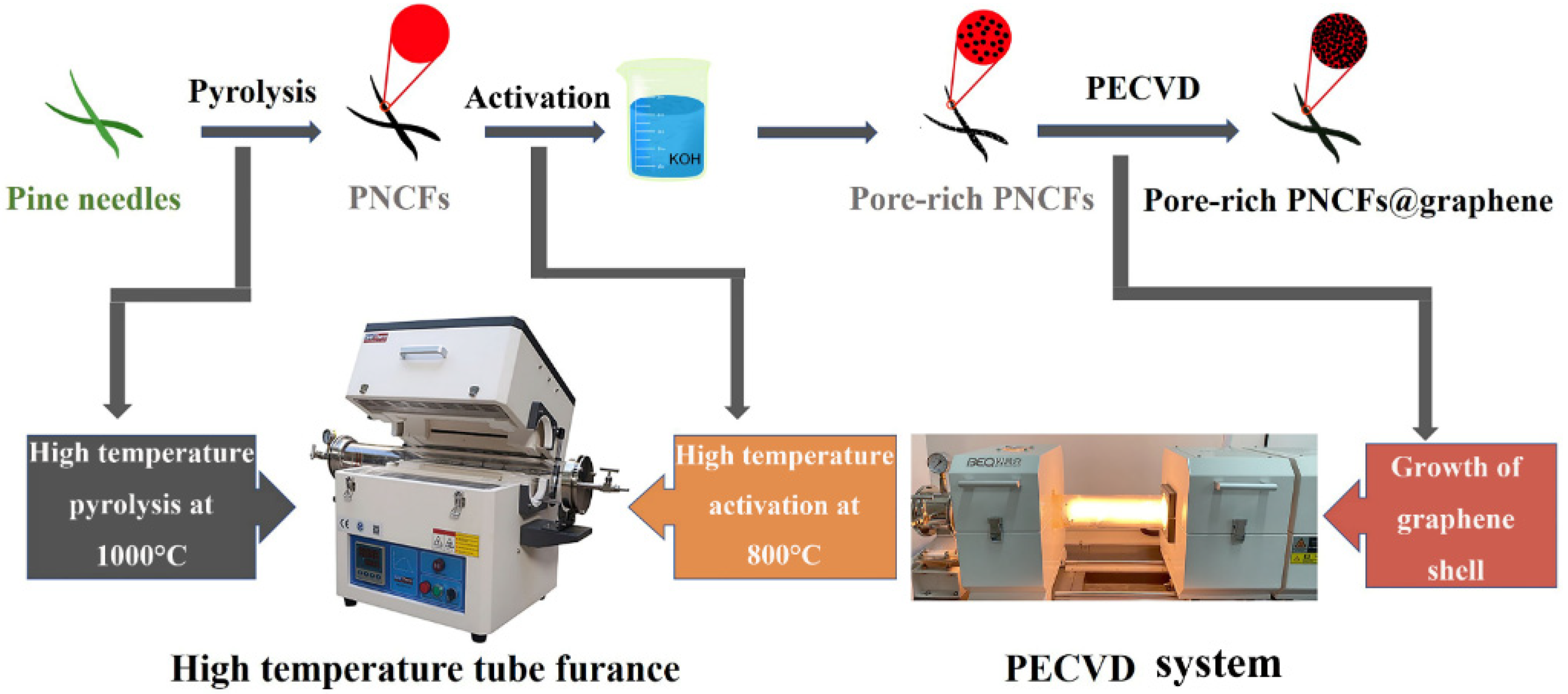
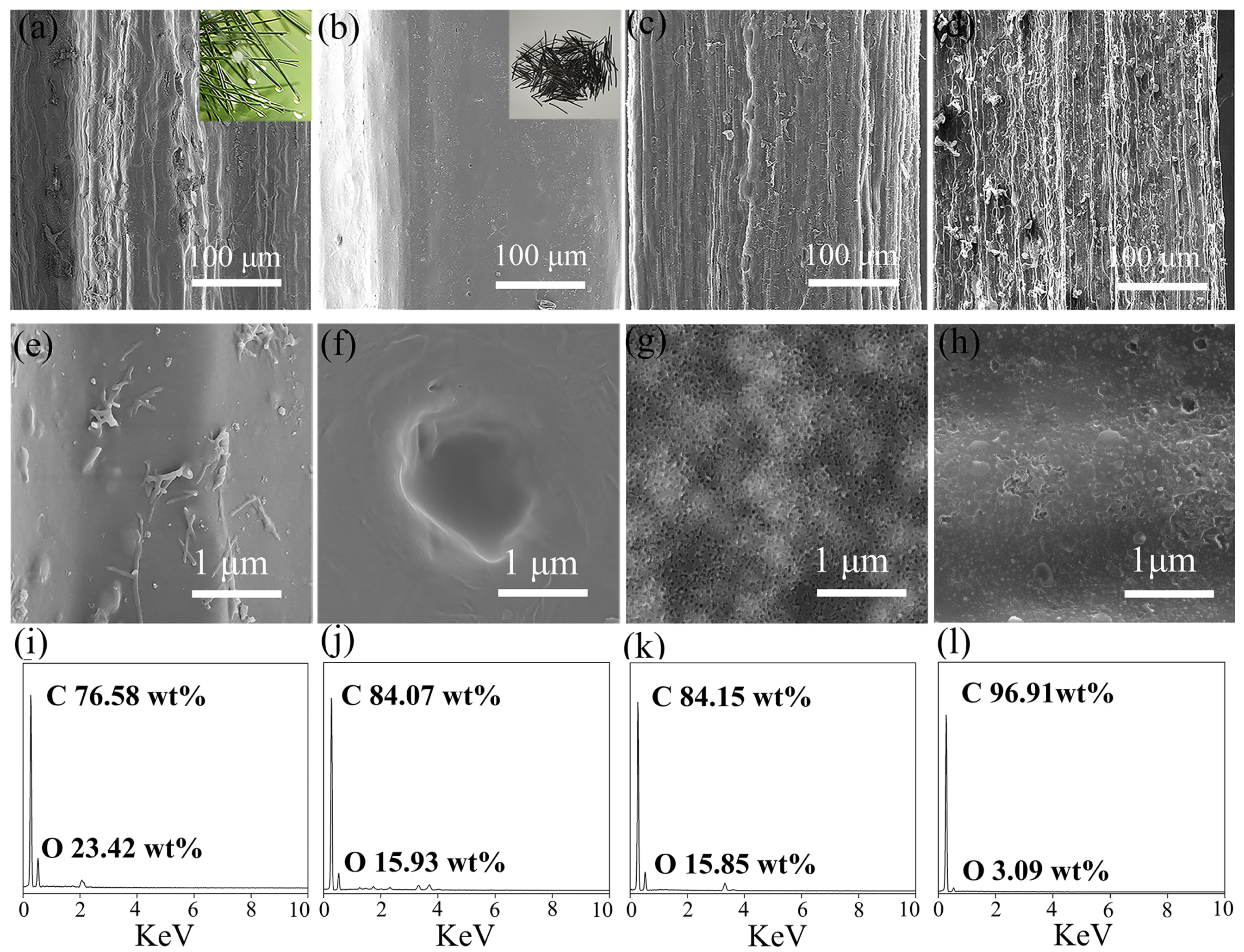
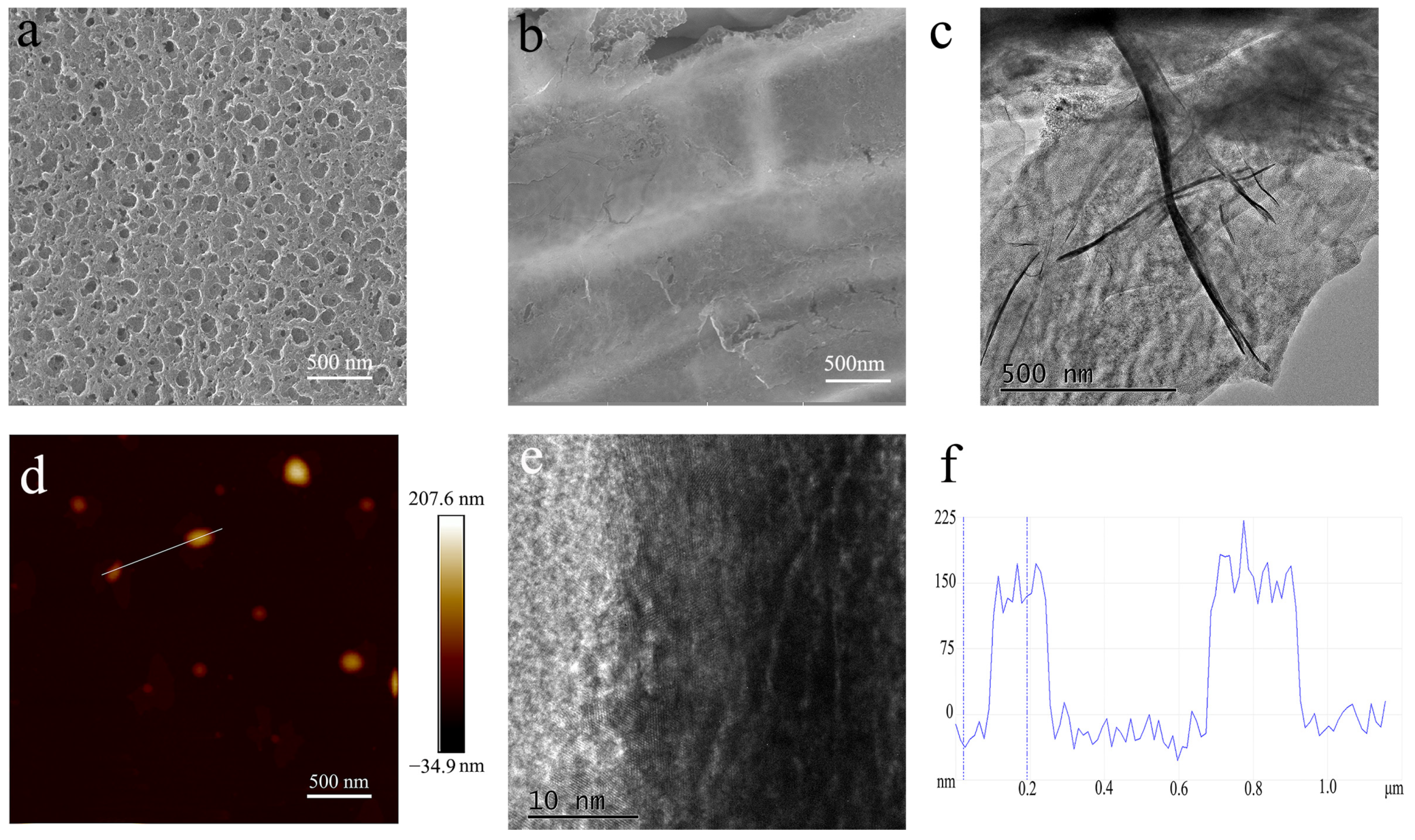

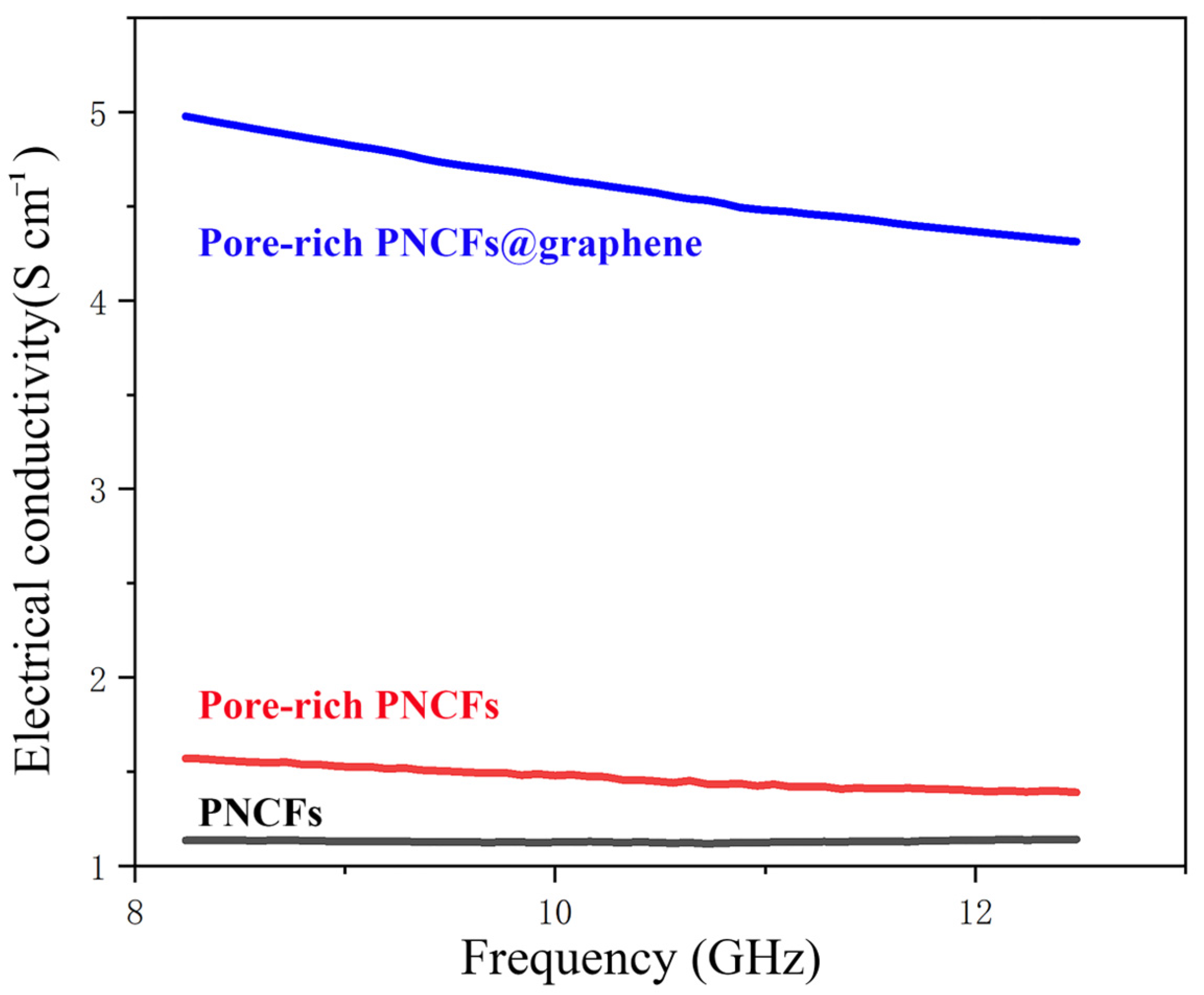
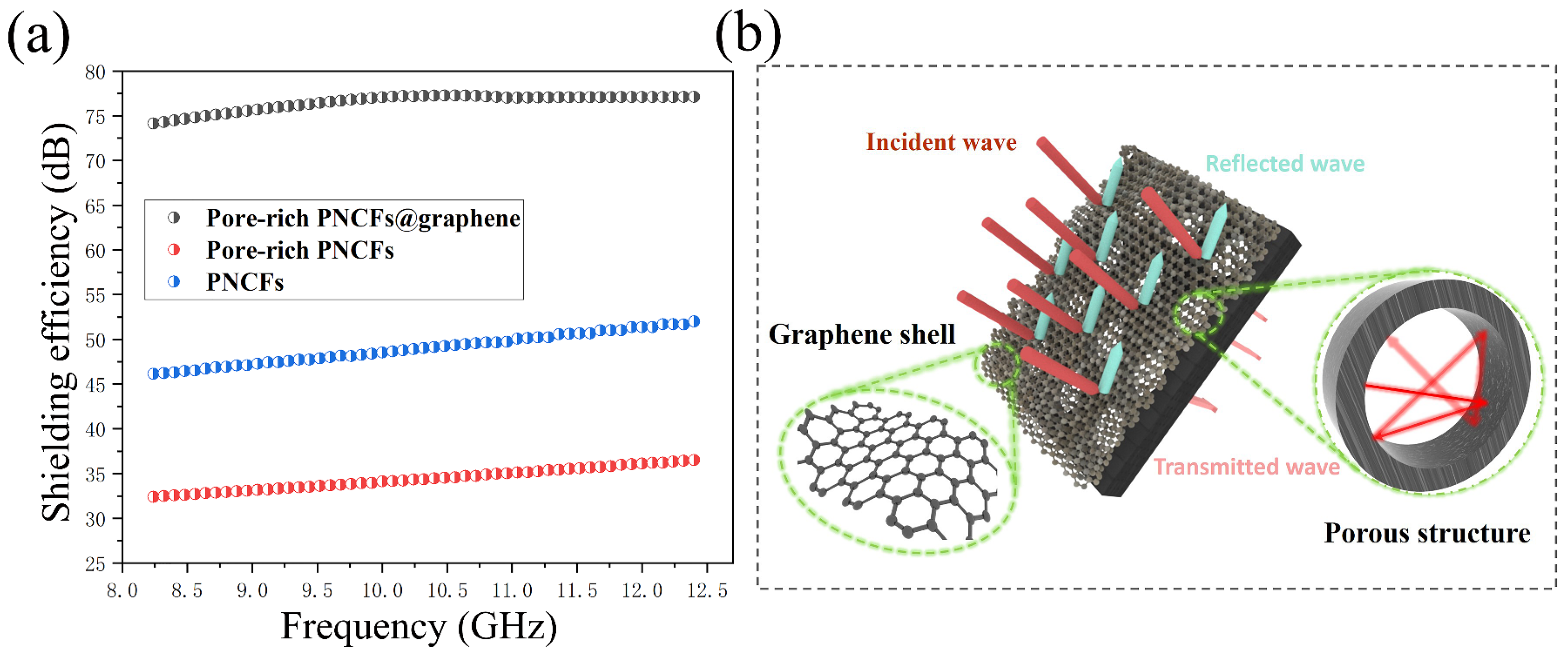
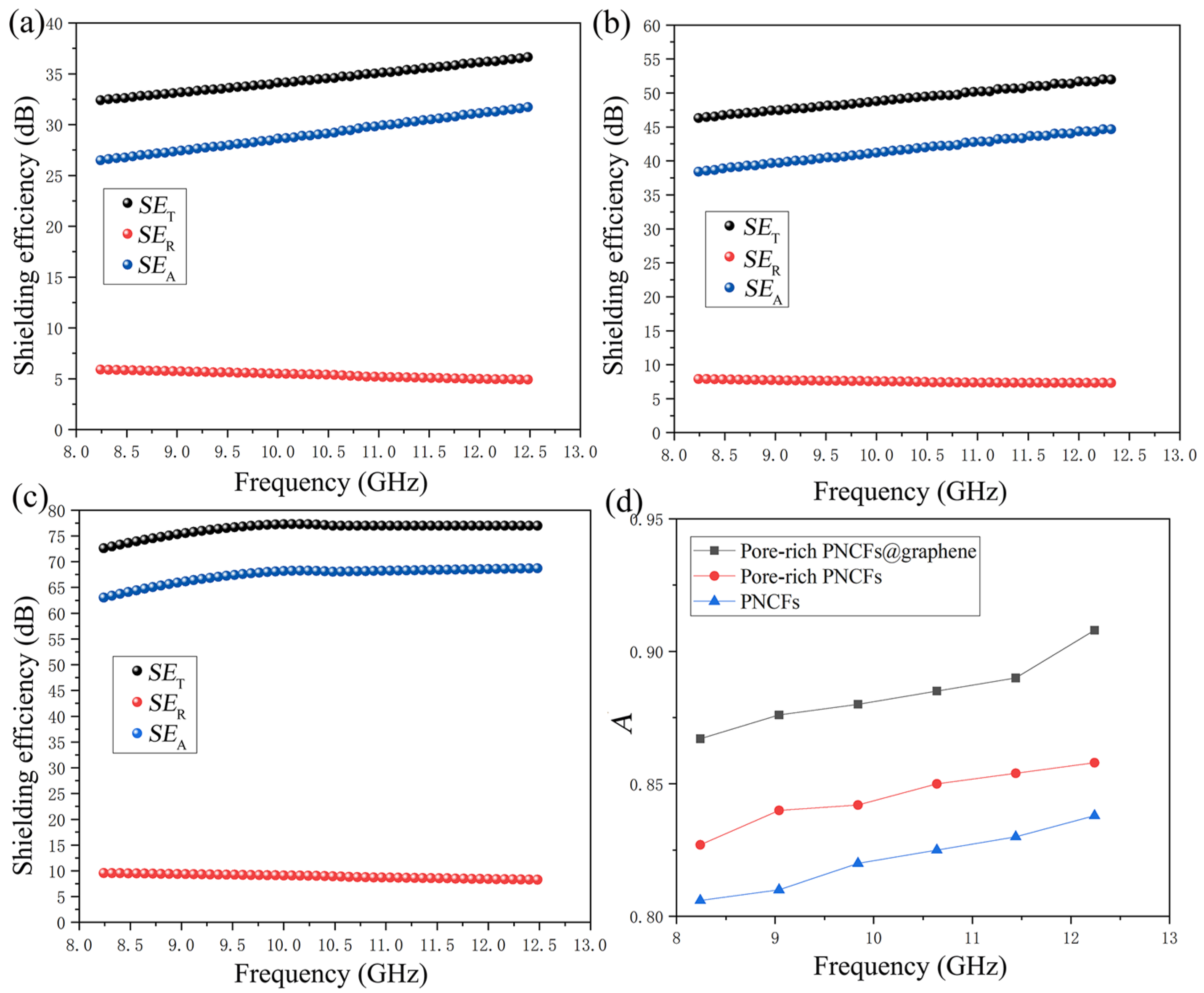
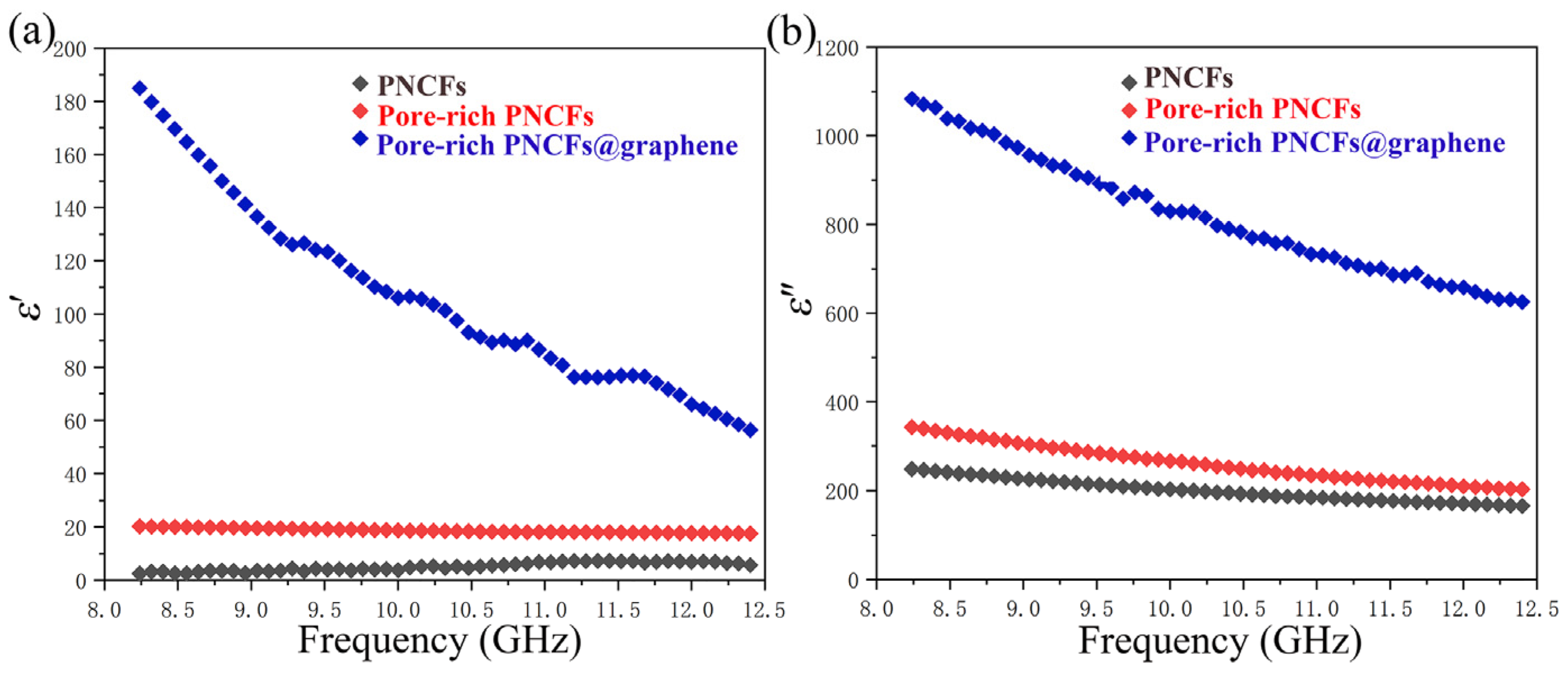
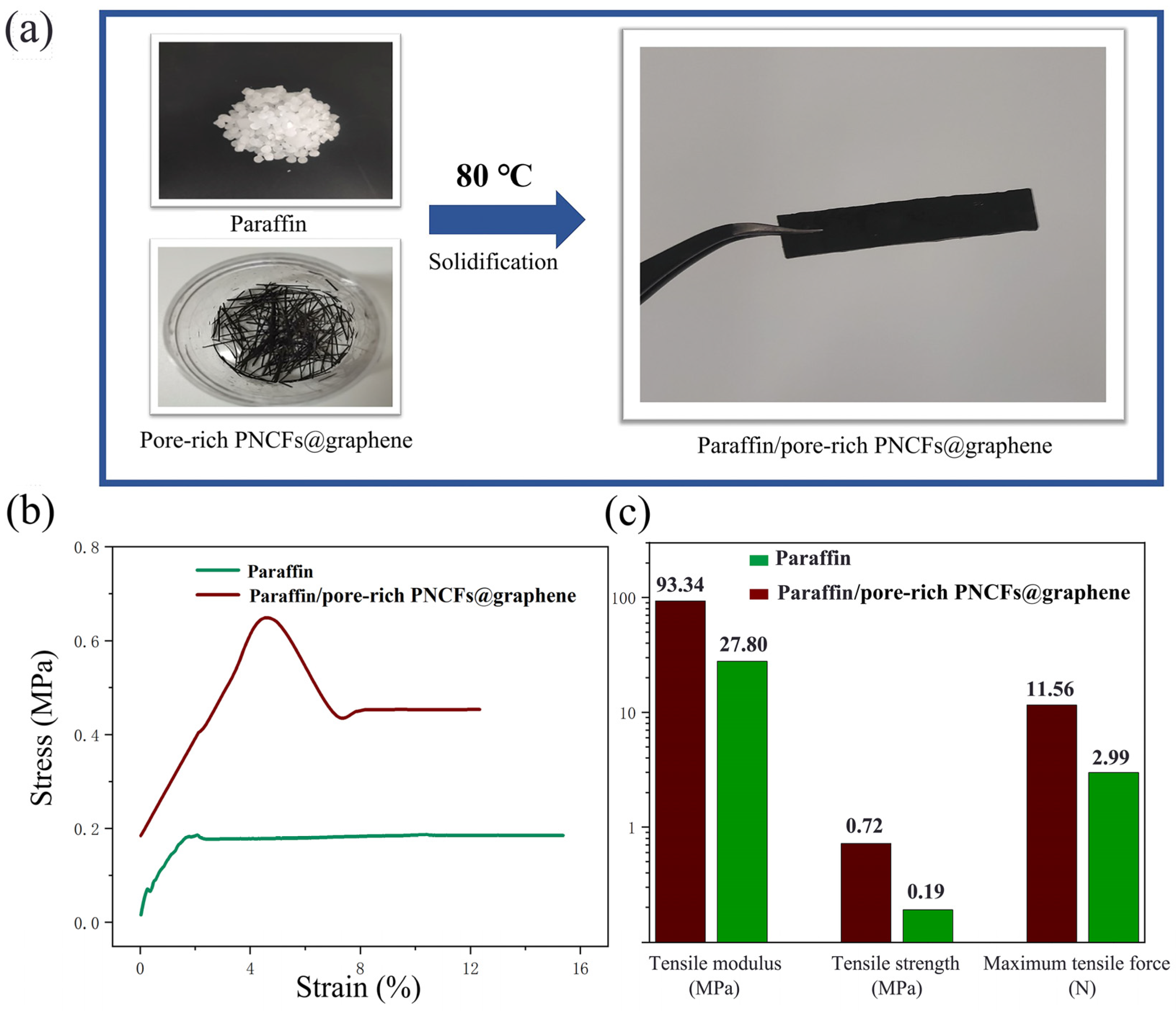
| Sample | BET Surface Area (m2/g) | Total Pore Volume (cm3/g) | Average Pore Size (nm) |
|---|---|---|---|
| Pine needles | 3.0 | 0.0047 | 6.22 |
| PNCFs | 333.2 | 0.17 | 6.55 |
| Pore-rich PNCFs | 498.1 | 0.22 | 2.20 |
| Pore-rich PNCFs@graphene | 699.1 | 0.40 | 2.83 |
| Samples | SET (dB) | Electrical Conductivity (S cm−1) | Frequency (GHz) | Ref. |
|---|---|---|---|---|
| Cs/epoxy | 28 | ~0.01 | 8.2–12.4 | [14] |
| Lignin-based carbon/graphene foams | 28.5–70.5 | ~0.98 | 8.2–12.4 | [51] |
| Loofah sponge-derived carbon/paraffin/urethane | 32 | - | 8.2–12.4 | [52] |
| PEI/PA@AgNWs | 32.9 | - | 8–18 | [16] |
| Epoxy/CNT sponge | 33 | 5.16 | 8–12 | [53] |
| Fe3O4@rGO/natural rubber | 37 | ~0.01 | 8.2–12.4 | [54] |
| rGO/polystyrene | 45.1 | 0.43 | 8.2–12.4 | [55] |
| MWCNT/water-borne polyurethane | 49.2 | 0.44 | 8.2–12.4 | [56] |
| ALC based on sugarcane | 51 | 0.09 | 8.2–12.4 | [15] |
| SC-Co-G | 55 | ~0.22 | 12.4–18 | [24] |
| Cotton fiber-derived carbon/CoFe alloy | ~62 | - | 8.2–12.4 | [57] |
| PNCFs | 36 | 1.13 | 8.2–12.4 | This work |
| Pore-rich PNCFs | 52 | 1.57 | 8.2–12.4 | This work |
| Pore-rich PNCFs@graphene | 77 | 4.97 | 8.2–12.4 | This work |
Disclaimer/Publisher’s Note: The statements, opinions and data contained in all publications are solely those of the individual author(s) and contributor(s) and not of MDPI and/or the editor(s). MDPI and/or the editor(s) disclaim responsibility for any injury to people or property resulting from any ideas, methods, instructions or products referred to in the content. |
© 2022 by the authors. Licensee MDPI, Basel, Switzerland. This article is an open access article distributed under the terms and conditions of the Creative Commons Attribution (CC BY) license (https://creativecommons.org/licenses/by/4.0/).
Share and Cite
Yang, Y.; Wan, C.; Huang, Q.; Hua, J. Pore-Rich Cellulose-Derived Carbon Fiber@Graphene Core-Shell Composites for Electromagnetic Interference Shielding. Nanomaterials 2023, 13, 174. https://doi.org/10.3390/nano13010174
Yang Y, Wan C, Huang Q, Hua J. Pore-Rich Cellulose-Derived Carbon Fiber@Graphene Core-Shell Composites for Electromagnetic Interference Shielding. Nanomaterials. 2023; 13(1):174. https://doi.org/10.3390/nano13010174
Chicago/Turabian StyleYang, Yadong, Caichao Wan, Qiongtao Huang, and Jun Hua. 2023. "Pore-Rich Cellulose-Derived Carbon Fiber@Graphene Core-Shell Composites for Electromagnetic Interference Shielding" Nanomaterials 13, no. 1: 174. https://doi.org/10.3390/nano13010174
APA StyleYang, Y., Wan, C., Huang, Q., & Hua, J. (2023). Pore-Rich Cellulose-Derived Carbon Fiber@Graphene Core-Shell Composites for Electromagnetic Interference Shielding. Nanomaterials, 13(1), 174. https://doi.org/10.3390/nano13010174







